Part one finished
This week: Part one finished; A lecture with questions; It’s a trade off;

It has been another busy week here in Dol, with a mixed bag of weather.
An afternoon shower early in the week passed very quickly, then there was a complete rainbow as the lowering sun shone through the fine mist of rain.
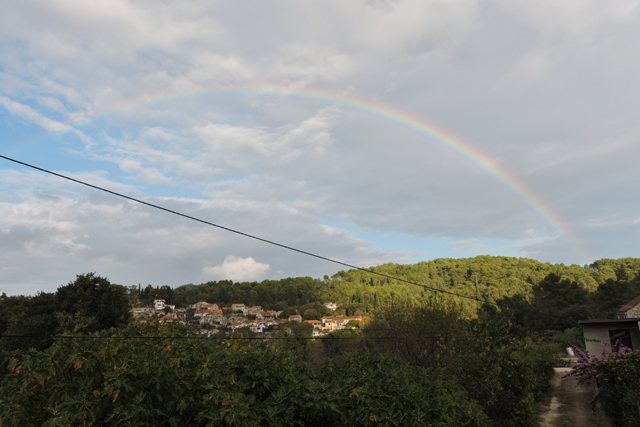
The clocks move back an hour tonight. This is another reminder that the Mediterranean winter is upon us. This is our cool and wet season.
Although at the moment it is neither cool nor wet.
A quick look at the weather stats this weekend shows we have had half the average rainfall in the last three months and the temperature is three degrees above the average.
Nothing is “normal” anymore.
I have been doing more work on the wood stove flue, with the pipe now through the wall from the dining room to the outside. The next job is to wrap the pipework in Rockwool. I bought the aluminium adhesive tape which will hold the insulation material in place this week.
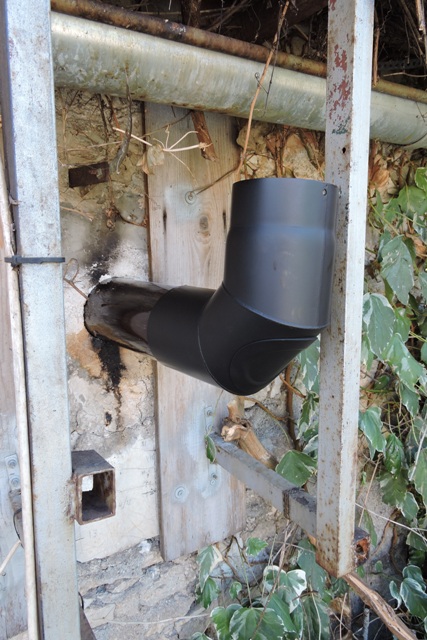
Inside I did a trial install of the air radiator with the new pipe through the wall. Everything was a tight but perfect fit.
Once the outside pipework is complete, I will be ready for the first winter fire. This is usually around the middle of November.
Walking up through the Maquis this week, there are just a few deciduous shrubs which are showing their finest autumn colours. The rest of the trees and shrubs are evergreen.


The Strawberry tree’s (Arbutus unedo) fruit are all turning yellow. This is one of the Maqui’s evergreen species of low growing shrubs.

Meanwhile around my home the Virginia Creeper looks fantastic at the moment.

Part one finished
Sometimes I feel that I start a project, duly report on it in the blog and then for any number of reasons, it never seems to finish.
Or when it does, the completion is so delayed that I don’t even report it. This week I can report on a success…
I have finished the new herbaceous border.
The job has not been without more drama though. As I kept digging out more and more stone, my plans for this area of the orchard changed once again.
I realised that the sheer amount of debris the rotary riddle was removing needed to be “put” somewhere.
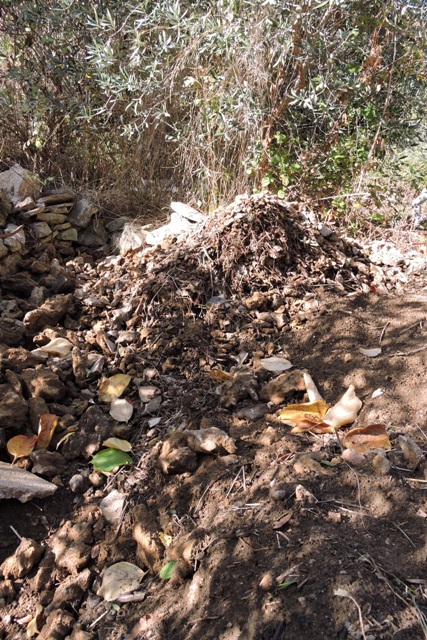
I decided that that “somewhere” would be a corner where I had intended to plant another tree, but instead I would dig deeper, fill the hole with stones and then cover it all in gravel.
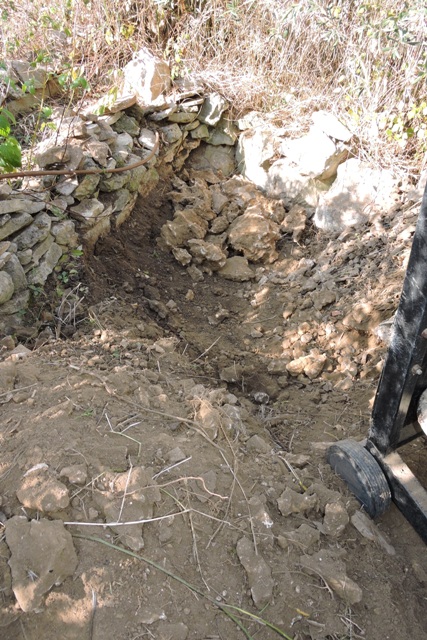

These two photographs show how the border looked three weeks ago and how it looks now.


After completely back filling between the rockery stones and the retaining wall, I completed the rockery stone corner, then covered the soil with a layer of well rotted turkey manure. My Vet breeds Turkeys for expats for Thanksgiving and Christmas, and sells the manure.
As it is delivered, it is extremely rich and virtually unusable. But after two years it can be put onto the soil.
I have a number of plants and shrubs ready to go into the new border, however I need lots of rain first.
What I have discovered while digging, really confirms my supposition that my orchard was a dumping ground for debris.
I dug out two pieces of concrete. These were 20 cm under the surface, but concrete is not natural!

A lecture with questions
I spent the start of this week preparing for a lecture I was asked to give on Wednesday afternoon.
Way back in July, which now seems to be an age ago, I accepted an invitation to present to the Hull University “War Studies Group” about police history.
I did question at the time my invitation because my experience is in general police history, not War time policing. There are people I know who are specialists in this area and know far, far more than I do.
However, the Uni response was that they actually wanted to hear about recent policing history. So I duly added the date in my Outlook calendar, did some preparatory work, wrote notes and headline points, created a powerpoint presentation and thought little more about it.
Fast forward to Monday morning and an email arrived, reminding me of the lecture with a link to the software programme. It was using “Google Meet”. I had expected we would use “Teams” or “Zoom”.
I’ve never used Google Meet, to be honest I didn’t know it existed until Monday!

There was then a very steep learning curve, lots of YouTube videos and reading up on how to use the software.
First off, I found I already had Google Meet installed on the computer. Next was how to “seamlessly” integrate Powerpoint into a presentation.
I often use on-line conferencing, whether that is talking with colleagues, attending on-line training, participating in meetings or giving a presentation.
I much prefer “presentation” to “lecture”. In presentations you talk to people, in “lectures” you seem to talk “at” people!
What I see so often is a good presentation failing because the technology didn’t work. I was determined mine would not be like that…
Everyone who has ever developed a Powerpoint presentation knows of the terrible affliction called “Death by Powerpoint”. They also know that the more interactive and multi-media (here read video) you add, the more likely it is that Powerpoint will lock up at the worst possible moment.
So I loaded one of my force’s corporate Powerpoint formats, had no more than 15 slides, had nothing moving and then made sure my notes and slides coresponded.

I am in this photo, managing a Silver Command when sections of the under construction Humber Bridge fell to the ground.
There was another curve ball on Wednesday morning when the presentation’s timings were changed, but I was ready! I’m a planner after all.
Come Wednesday afternoon, by the skin of my teeth I was ready and had changed from work clothes to more appropriate dress.
There was a time on the BBC radio service that all presenters had to wear Evening Dress. For radio!

It was believed that formal dress “focussed the mind”… I went for something slightly less formal so my mind could focus on the topic.
I even managed to get the chairperson to do a partial dry run beforehand to make sure the technology at both ends worked. It did.
The presentation could have been more fluid in the changes between the talking head (me) and the powerpoint slides, but overall it was OK.
There were lots of questions at the end and following feedback from the organisers, I might even be invited back for “Round Two”….
Life is never dull in Dol.
It’s a trade off
Watching the weather this week, together with the 11 day average temperature for the inside of my Polytunnel, I decided that I needed to put the winter cover on the shade netting. This was because the temperature slowly dipped below 17°C.
I have winter collards and some temperature sensitive plants growing, things like Sweet Potatoes, tomatoes and peppers.
The problem is that I have no idea what the coming winter will be like, because of climate breakdown.
I do know that the coldest weeks of the year are either side of New Year (just 9 weeks away!). Having said that, it is possible that we can have cold weather up to the middle of March.
Our effective last frost date is the 14th February, based on 30 year temperature’s recorded by the DHMZ – the Croatian Meteorological and Hydrological Service.
Last winter I recorded just two nights when the temperature dropped below zero for a short while. It reached -0.5°C, so hardly ice making.
Knowing I needed to renew the wooden lats which hold the plastic in place, I removed them while the sun shined. They had deteriorated more over the summer, rotting away from this inside.

I have used the cheapest possible wood, without any treatment, knowing it will last only four or five years. But the cost of replacement against the cost of regular wood treatment is negligible.
Next I reused lats that I removed when I replaced the plastic roof which links my buildings, so no need for new. The holes for the bolts were drilled and then I waited to see if they were in the right place.
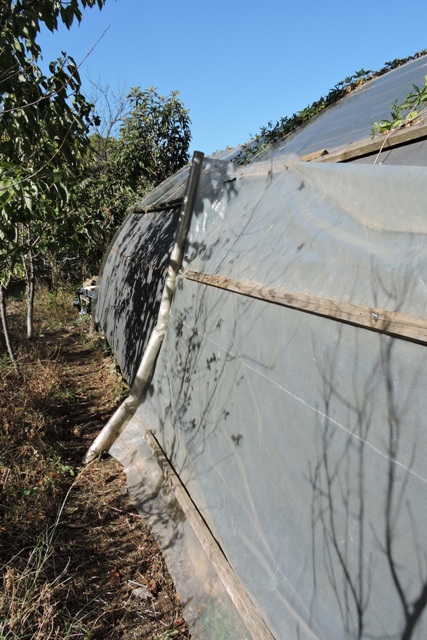
I had seen that we were going to have rain overnight on Thursday and I wanted to harvest the rain, falling through the shade netting, before sealing the polytunel with its winter plastic coat.
On Friday I started the job of fitting the plastic cover, securing the replacement lats and the Inox fittings. I also treated the threads with WD40, just for good measure.
Unrolling the cover, I found that in a couple of places, the polythene sheet is decaying because of exposure to sunlight.
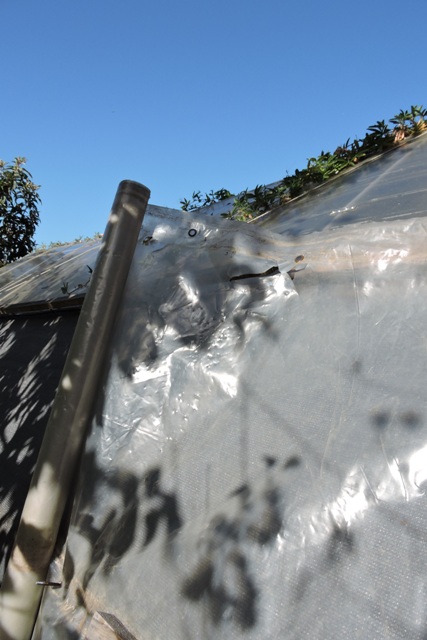
The damage is not so great that I can’t use it this winter. However this will be the last full winter and I will need a new cover next year.

It has really been a trade off. I usually make the change when the daily 11 day average hits 19°C, however I decided that a little below would not be a problem AND I would rather harvest and use the scarce rainwater… NCG